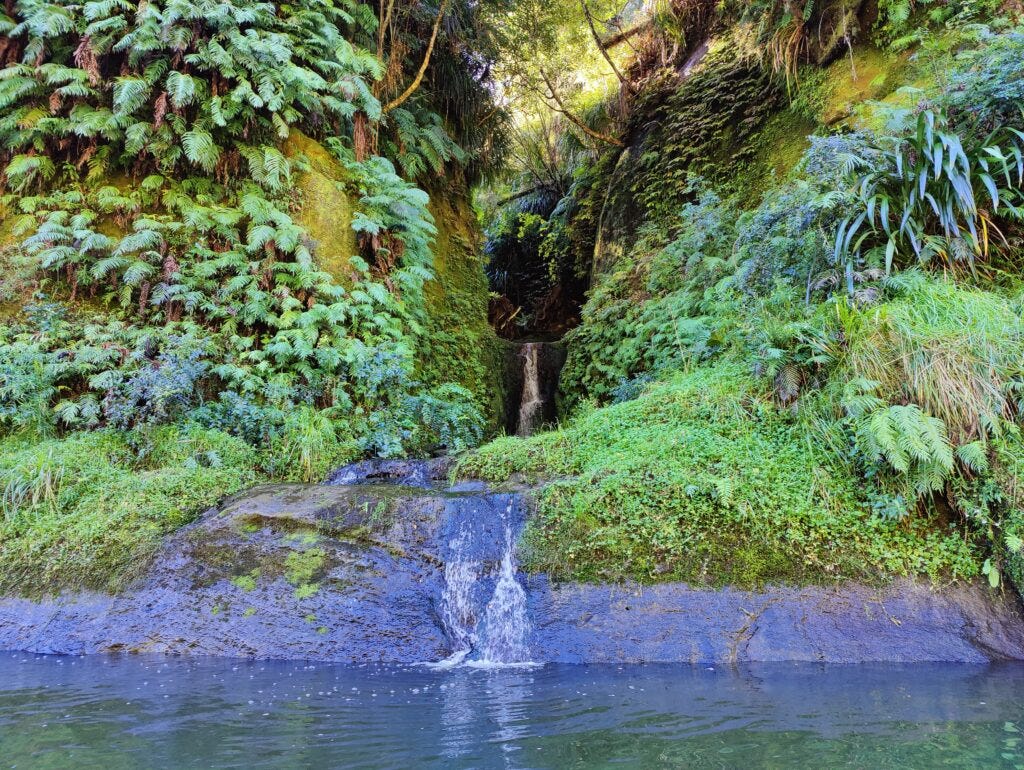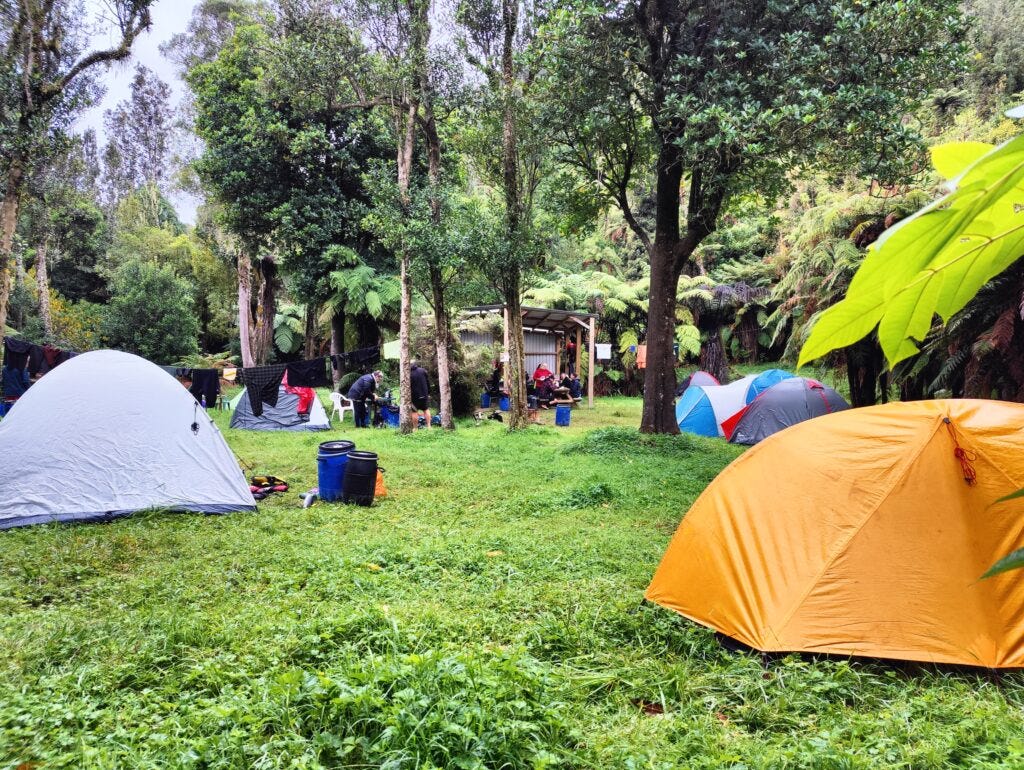Waka & Waewae Day 33: Whakahoro to Mangapapa Pā
Off on the Whanganui River!
I woke up and packed down my tent at the Whakahoro DOC campsite. Gear loaded, I trudged over the gravel road to the Blue Duck Station Cafe, the scene of the previous night's gorge-fest. Upon arrival on the Thursday, I'd booked in to have dinner on the Friday night. As it happened, I was the only vegan attending and we all know what that means: more food! More food than I could physically handle, I discovered as I edged my way back to my tent, taking only pigeon-steps so as not to force any pre-digested mash and stew out of my crammed gullet and onto the ground. I still do not know how I managed to lay down and sleep, but it was easily the best $29.50 I've ever spent.
"Just a slice of toast and a soy flat white, please Karen!" I was in no mood for another eating event. Besides, I had be at the water's edge at 8:45am. There I would meet Willie Huch, my guide for the river. Willie, with Owhango Adventures, was taking a party on a cultural guided tour down the Whanganui River and I had permission to tag along.
I had spent my day off in Whakahoro catching up on the world aboard the Blue Duck Cafe wifi. I had also taken a nice hike up a farm track to a waterfall. Sadly, neither of these had fixed my wrist. Ibuprofen took a lot of the pain away, but the discomfort lingered on. The choice between turning back to Taumarunui Hospital or ploughing on down the river and hoping to make Whanganui presented little choice to this old, stubborn Taurus bull. Grant from Owhango Adventures had arranged for me to join this journey and not a lot was going to make me miss it!
The launch area on the banks of the Rētāruke River was bustling with people when I arrived. People unloaded canoes from vans, others stood around in circles receiving a briefing from their rental company. "Dunc?" asked a man as I made my way down the muddy slope to the pebbly launch area. I was in the right place!
Listening in to parts of the briefing, I inflated my raft and began readying for launch. Busy with prep, I flashed a wave towards Willie, intending to pop over and greet him properly once I was ready to set off. Next time I saw him, however, he was climbing aboard his waka and setting off. Five minutes later, I jumped into my (inflatable) waka and did the same.
Unlike the previous day of rain, the sky was blue and the sun was shining. I paddled over a very gentle rapid and then out into the Whanganui River itself. Another gentle rapid greeted us, before the side walls rose up and we entered the gorge. This was it: the Whanganui National Park. We were running New Zealand's longest navigable river! From Auckland to here, by boat, on foot, this journey had already been incredible. Nothing could change that now. Incredible was locked in, it could only get better from here!
Despite being the location of a 'Great Walk' and a landmark of New Zealand, the water of the Whanganui is less than pretty. Even the perfect blue sky couldn't catch a half decent reflection in its green-grey murk. Fortunately, the surrounding rainforest is more than enough to satisfy one's cravings for nature and I paddled along slowly, but gleefully, hoping to catch up to my party.
I eventually did catch them, at Mangapapa Campsite. They were partway into their first rest stop of the day. I negotiated a small rapid and threw a hard left to land on the rocky outcrop below the camp on the grassy slopes. On land, I was able to meet Willie properly and meet some of the other guests on his trip. It was time to refuel. As I tucked into a peanut butter sandwich and the last of my giant walnuts, a kayak with a young man in came crashing into the rocky bank. His compadres, a man and woman, weren't far behind in an Owhango canoe. They told me how they'd chosen the canoe-kayak combo since they were a trio and it meant they could all take turns trying the different vessels. Unlike the lad's kayak landing, this seemed sensible.
Excited to continue, I re-rolled my pack's drybag and hopped back into my boat. We were just a few hours in and I'd noticed something magical about the water on the river. It gives the impression that it is - or it is - gently sloping downhill, towards the ocean. This illusion - or actual feature - persisted throughout my time on the water. Yet, despite this, I was getting a sense of just how slow and laborious paddling it by packraft was going to be. Nimble for their width, these stable crafts are designed to blast down white water. Sitting atop the slow-moving waters of the Whanganui is a doable feat, but it's the action-adventure equivalent of watching dishes dry.
Fortunately, the scenery more than made up for it. My neck swung from left to right as we floated gently past tiny waterfalls, trickling down the steep gorge walls to join the river. Some had been around long enough, with flows strong enough, to carve their own path through the gorge and dropped less than a metre.
The gorge, however, has its pitfalls. The meanest one I discovered during the second break at Ohauora Campsite. Despite being togged-up properly in my wetsuit, I got cold. Very cold. I was only out of the boat for 20 minutes, but the gorge side was blocking the late-autumn, late afternoon sunshine and my teeth began chattering. Fortunately, I soon had something to take my mind off it.
A guide from another canoe company had pulled up on the stony beach and was directing paddlers on his tour in to join him. It was a fairly basic landing, with a mid-sized rapid roughly halfway along the beach. Some of his tour had opted to pass the rapid, then dock. Others were stopping before it. As I prepared to jump back into my raft and warm myself up, I noticed two people in a canoe attempting to land just upstream of the rapid. Facing the beach, they were paddling towards it, but I could see the rapid had hold of them.
"Oooh, we've got someone about to go down that backwards," I alerted the guide, whose attention had momentarily been taken by another party member. He turned and dashed down the beach to verbally assist them. I jumped in boat and made my way towards the rapid, after them. My raft easily sploshed through the churning waters and I paddled into the returning eddy on the other side.
"Are you all good?" I called out to the pair as I neared them and the lower beach. Somehow, they'd made it through okay, their egos slightly dented. "Yep!" one of them replied, somewhat ashamedly, as they landed on the beach. Their guide followed up to check they were okay.
"Wow. They really do just let any putzes loose on this river," I thought.
With nothing left for me to do, I returned to the snail-pace task of paddling the awa. If there was one good thing about the cold, it was that it masked any wrist pain I might have otherwise been feeling. The constant cold water dipping throughout the day had rendered it painless. Probably not healed, but painless.
Camp wasn't far. Just a brief paddle after the popular John Coull DOC camp and hut is a bend in the river. Situated there is a private, and well-hidden, campsite, owned by the iwi. As one of the guests in Willie's party later explained to me, the advantage of going down the river with Owhango Adventures is that they have access to this accommodation, even when the DOC sites are fully booked.
I hopped out of the raft onto the pebbles that cover much of the inner meander. Canoes were lined up, well away from the water. A couple of guests were dashing through the shrubs, down a path from the camp. Once at the beach, they began collecting firewood. I stowed my boat, turning it upside-down and securing it with several strategically-placed rocks. The shivers had returned. I needed to chuck on my warm, dry clothes ASAP, however there was nowhere private for me to do it. I would have to put my tent up first, and to do that I needed to walk up the hill to camp.
Grinning and bearing my way through the urge to shiver wildly, I grabbed my gear and slung my pack on my back, over my PFD. The walk up and through the bush to camp was only short, but in my cold state it felt like an age. There was the initial steep, grassy section, complete with muddy mounds to negotiate; then there was the bush section, which climbed up steps and passed an aged wooden longdrop toilet. A giant clearing in the bush then signified the campsite. It was spacious, with lush, green grass across its floor. A large, newly built, cooking shelter inhabited the rear of the site. Near to that, several chairs were placed around a metal fire bucket. I sensed warmth.
Springing to action, I threw my tent up in what felt like a single movement. My teeth were chattering loudly, drowning out all the sounds from the other campers. I slipped into my tiny hobbit house and peeled my wetsuit off in the same action, all while zipping up the tent door. In another action (which actually may have been the same action, I don't really know) I whipped my dry clothes and polyprops from my dry-pack. Then, through a combo of writhing and fidgeting on the tent floor, I got into my dry clothes and began the slow process of turning them into the outdoor safety item known as "warm, dry clothes".
Next in the warm-up process was dinner, which consisted of a dehydrated meal from my large stash, rehydrated for my consumption. Cooking in the large shelter, I met many of the other guests on the trip. This included the trio in the canoe and kayak combo, who had arrived at camp after me. A fire was lit and we all huddled around it, sharing treats, as our host Willie welcomed us all and told tales of his time on the awa.
Kia ora, thank you for reading about this epic adventure! The Waka & Waewae Journey is raising money for the Mental Health Foundation, Cancer Society and UNICEF's Ukraine appeal. I'd love it if you're able to donate or simply share my Givealittle fundraiser with your pals. Ngā mihi nui!



